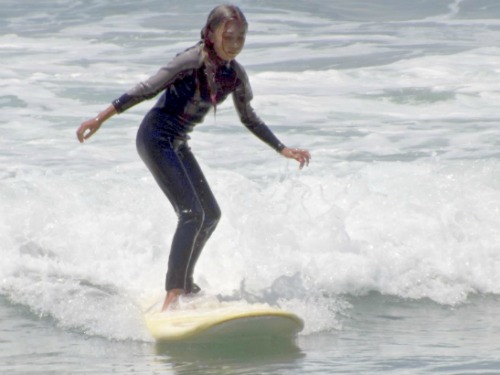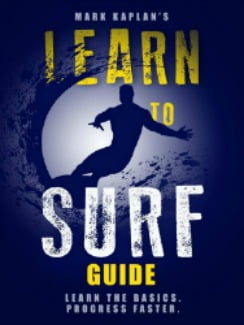Surfers learn basics in foam waves on soft top boards before progressing to bigger waves and hard boards. Surfing techniques are not difficult and stay the same from beginner to advanced. This is why it is crucial to get the basics correct.
The beginner techniques develop muscle memory so that catching and popping up on waves doesn’t require a lot of thinking. In bigger waves, there is little time for thinking and no room for mistakes or poor technique.

What Are the Basics
The beginner surfer learns how to lie properly on the surfboard. This requires more precision than most beginners realize and they often have trouble with this simple basic. Surfers have to paddle keeping the board going straight and balanced.
Next the beginner surfer learns to catch waves. This is about timing, positioning, and paddling. Surfers also develop wave sense so they know which is a good wave. The big difference between catching foam waves and real waves, considering the technique is good, is timing. The foam wave can be seen coming for a distance while the real wave forms in one spot for a few seconds.
The pop up for a beginner is a sequence of small moves to arrive at the perfect posture on the surfboard. The surfboard is designed to be maneuverable with weight transfers, so it is sensitive to how the surfer’s body is positioned.
Riding the surf board is easy if the body is positioned correctly. The surfer wants his feet shoulder width apart with hips and shoulders squared to the front. Weight is equal on the front and back leg and the upper torso is upright over both legs. If the board goes straight without work, the surfer’s posture is perfect.
Advancing in Foam Waves
After the beginner surfer learns to ride foam waves to the beach, he can begin paddling out for bigger waves and shots at real waves. The surfer runs the nose of the board through the foam and does a push up to allow the foam wave to go under his chest.
Then he turns 90 degrees to wait for the next wave. Turning is accomplished by pushing water under the board with one arm while paddling regular with the other arm. When the wave is close, the surfer turns the next 90 degrees toward the beach and catches the wave.
Catching real waves begins with small ones that come in between the foam waves. Sometimes you can run down the face and other times you catch them at the corners as they unfurl. To catch a corner, you paddle at 45 degrees toward the beach and let the rolling pocket come under the board. Then paddle hard and pop up.
At this point the surfer is becoming an intermediate and can start moving toward catching more real waves and bigger ones.
Learn More
My New Surfing Course in an E-Book plus Demo Video or Audio Version
Get the 18 Chapter, 7,500 word Course that can prepare you for a lesson or give you the fundamentals if you are going to try it on your own. 10 years of teaching 350 students a year has given me the insights on the most precise measures you must follow for success. This course is what I teach on the dry land and in water instruction. The Course includes a 15 minute video on my dry land and in water demonstration. Only $4.95
Buy the E-Book and start learning $2.99. Learn to Surf
Buy the Paperback on Amazon $7.95
Get Learn to Surf Course in 29 minute AUDIO. Great prep for a lesson, reviewing after a lesson, learning on your own, refreshing after not having surfed for a while. See Table of Contents. Only $7.95.

For Oceanside Surf Lessons, see the Home Page
See the Post Search Lessons Teach Fundamentals
See the Post Catching Real Surf Waves
See my Dry Land and in Water Demo video
See my other Surf site for more Posts
I have lowered the price of Courses and Books for the lock down price of $2.99
80 page Learn to Surf Book
![Surf Instructions Beginner to Advanced: Learn to Ride Waves by [Kaplan, Mark]](https://images-na.ssl-images-amazon.com/images/I/51HswFtoBQL.jpg)